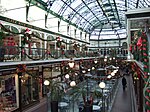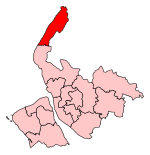Southport Town Hall
Buildings and structures in SouthportCity and town halls in MerseysideGovernment buildings completed in 1853Grade II listed buildings in MerseysideUse British English from April 2022

Southport Town Hall is on the east side of Lord Street, Southport, Sefton, Merseyside, England. It was built in 1852–53 in Palladian style, and extended to the rear on three occasions later in the century. The town hall has a symmetrical stuccoed façade with a central staircase leading up to a porch flanked by columns. At the top of the building is a pediment with a carved tympanum. The town hall is recorded in the National Heritage List for England as a designated Grade II listed building.
Excerpt from the Wikipedia article Southport Town Hall (License: CC BY-SA 3.0, Authors, Images).Southport Town Hall
Cambridge Arcade,
Geographical coordinates (GPS) Address External links Nearby Places Show on map
Geographical coordinates (GPS)
| Latitude | Longitude |
|---|---|
| N 53.6475 ° | E -3.0056 ° |
Address
Southport Town Hall
Cambridge Arcade
PR8 1AS
England, United Kingdom
Open on Google Maps










